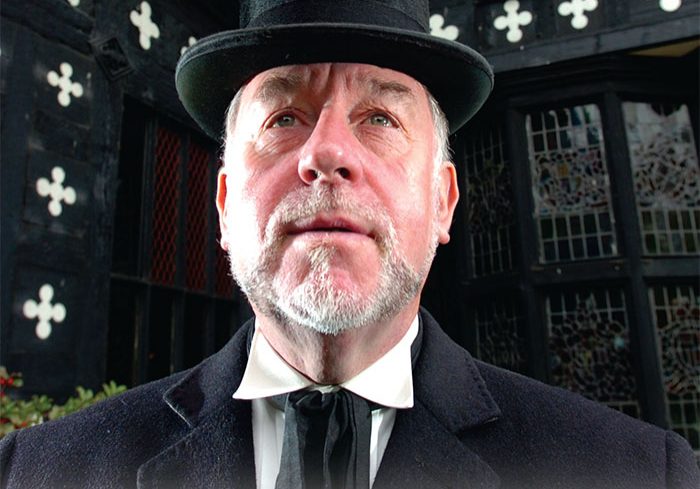
Ghostly Goings On
by cdno
 If ghosts are your thing, Simon Entwistle is your man. He can most often be found, top hat proudly atop head and black cape ruffling in the wind, leading a group of petrified looking mortals around Clitheroe, Blackburn, Skipton, Settle and a whole bunch of other Northern towns, regaling them with the grim and gruesome details of the ghouls and gremlins that haunt the various darkened nooks and crannies.
If ghosts are your thing, Simon Entwistle is your man. He can most often be found, top hat proudly atop head and black cape ruffling in the wind, leading a group of petrified looking mortals around Clitheroe, Blackburn, Skipton, Settle and a whole bunch of other Northern towns, regaling them with the grim and gruesome details of the ghouls and gremlins that haunt the various darkened nooks and crannies.
There’s every chance that you could be leafing through this edition of Northern Life on Hallowe’en so it makes sense to let Simon introduce you to his favourite ghost stories from our area, starting off with his favourite ‘haunt’ in Lancashire. Samlesbury Hall near Preston has a rich history of murder and intrigue, meaning that its corridors creak with the restless spirits of old.
Most famous is the White Lady, thought to be Dorothea Southworth. She was said to be the daughter of the Catholic family of the manor who fell in love with a local Protestant. Their affair continued in secret for some months before the couple decided to elope. Having got wind of their ploy, her brother lay in wait for her paramour and stabbed him and two accomplices to death.
The family banished Dorothea to a nunnery where reports suggest that she went insane with sorrow and died soon after. Her ghost is said to haunt the Hall where three skeletons were discovered in the 19th century, adding credence to the tale. Could Dorothea be the gaunt apparition that so many staff and visitors claim to have spotted, floating down the hallways, crying for the love that she lost?
Dorothea doesn’t have exclusivity when it comes to haunting rights at Samlesbury though. The Great Hall plays host to a cavalcade of ghouls, laying in wait for unsuspecting guests. There have been reports of mysterious slaps to the back, moving shadows and uncomfortable feelings at weddings that weren’t directly related to the best man having overindulged before his speech.
Many visitors to the Hall have talked of seeing a ghostly woman dragging the spirit of a child down the corridor. There is a video purporting to show this apparition on YouTube but, in the kindest terms possible, it is so shaky and blurred that this particular spotting may have to be filed under ‘inconclusive’ for the time being.
Historians tell of a priest in the 1500s being pursued by soldiers into the building, baying for his blood. The priest apparently attempted to escape into one of the Hall’s myriad secret hiding places but was spotted, captured and beheaded on the spot. The floorboards of the room were so stained with the priest’s blood, it is said, that no one could scrub it away. The room was bricked up until the late 19th century and, when reopened, servants refused to enter the room until they were all replaced. Even after new floorboards were laid, the bloodstain is still reported to reappear from time to time, even now.
Add to the above the fact that Samlesbury was the home to three women accused of witchcraft, child murder and cannibalism in the early 1600s, one of whom would be related to Dorothea by marriage and you can see why Samlesbury is a honeypot for those of a ghostly bent in Lancashire.
As for Yorkshire, Simon recommends this tale from the mid 1950s in the city of York.
Harry Martindale was an 18 year old apprentice at Souksmiths, a plumbers based on Micklegate in the city. He was sent alone to work on the central heating system at the Treasurer’s House, associated with the men who held the purse strings at York Minster up until the dissolution of the monasteries in the mid 16th century.
It was February and bitterly cold so the work was important but Harry was certain that the curator of the building wasn’t keen for him to be there. When Harry asked to borrow a ladder, the curator would only lend him a broken one with rungs missing but he had to get on with the job.
He set about knocking a hole in the ceiling of the Treasurer’s House’s cellar in order to fit a pipe, having placed his ladder on the section of the ground which had been previously excavated to reveal a portion of an old Roman road. Harry swears that, at the time, he had no idea of what the excavation had uncovered.
As he was hammering away just before midday he was struck by the sound of what he describes as ‘the blaring of a note’. There was no apparent tune, just a long, loud note that distracted him from his task. Being well away from any other person and the nearest room being the boiler room where it was unlikely that anyone would sneak in to start playing around with musical instruments, he was concerned to say the least.
The volume steadily increased and, once he’d stopped to listen carefully, Harry realised that it was coming from within the wall against which his ladder was propped. Three rungs up the ladder and now seriously panicked, Harry glanced around to see if he could work out what was creating this eerie racket. And that is when he saw the figure.
At the level of his waist, to his right hand side, he noticed the top of a plumed helmet; it came through the wall atop the apparition of a Roman soldier. Harry’s instinctive reaction was to take a step back, however, seeing as he was halfway up a rickety ladder, he fell backwards, landing on his backside and he scrabbled to the corner of the room, horrified by the vision. The soldier stepped through to where the road had been unearthed and, for the first time, Harry saw him in his full finery, right down to his sandals. He had leather on the top of his outfit and a green material skirt. On his right hand side he carried a short sword, like an oversized dagger and in the other hand a large shield with a round bulb in the middle.
As if that were not terrifying enough, following the soldier came another but this time he was on horseback. Harry describes it as a ‘great big carthorse’ with ‘really bushy fetlocks’. He was petrified, frozen to the spot in fear of what might happen if they spotted him. The figures slowly disappeared past him, trailed by twenty other Roman foot soldiers, walking in pairs and finally another character carrying a trumpet-like instrument in a condition he describes as ‘battered and worn’. Perhaps the source of the initial blaring noise?
As quiet descended once again on the cellar, soldiers having disappeared as promptly as they arrived, Harry picked himself up and frantically scrambled up the stairs and out of the door before running straight into the curator who took one look at him and quietly intoned, ‘from the look of you, you’ve seen the Roman soldiers’.




